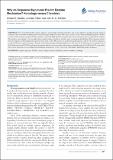Why do sequence signatures predict enzyme mechanism? Homology versus Chemistry
Abstract
We identify, firstly, InterPro sequence signatures representing evolutionary relatedness and, secondly, signatures identifying specific chemical machinery. Thus, we predict the chemical mechanisms of enzyme catalysed reactions from “catalytic” and “non-catalytic” subsets of InterPro signatures. We first scanned our 249 sequences with InterProScan and then used the MACiE database to identify those amino acid residues which are important for catalysis. The sequences were mutated in silico to replace these catalytic residues with glycine, and then again scanned with InterProScan. Those signature matches from the original scan which disappeared on mutation were called “catalytic”. Mechanism was predicted using all signatures, only the 78 “catalytic” signatures, or only the 519 “non-catalytic” signatures. The noncatalytic signatures gave results indistinguishable from those for the whole feature set, with precision of 0.991 and sensitivity of 0.970. The catalytic signatures alone gave less impressive predictivity, with precision and sensitivity of 0.791 and 0.735, respectively. These results show that our successful prediction of enzyme mechanism is mostly by homology rather than by identifying catalytic machinery.
Citation
Beattie , K , De Ferrari , L & Mitchell , J B O 2015 , ' Why do sequence signatures predict enzyme mechanism? Homology versus Chemistry ' , Evolutionary Bioinformatics , vol. 2015 , no. 11 , pp. 267-274 . https://doi.org/10.4137/EBO.S31482
Publication
Evolutionary Bioinformatics
Status
Peer reviewed
ISSN
1176-9343Type
Journal article
Collections
Items in the St Andrews Research Repository are protected by copyright, with all rights reserved, unless otherwise indicated.

